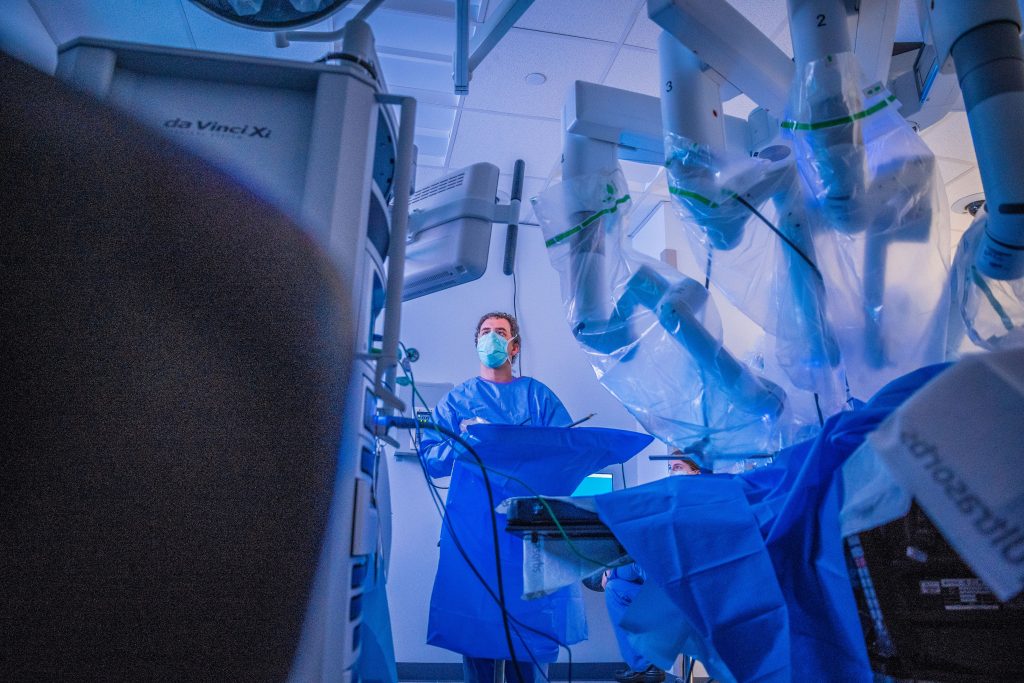Dr. Brian Boone, assistant professor in the WVU School of Medicine Department of Surgery, participates in a simulated surgery using the da Vinci robotic-assisted surgical system that allows procedures to be performed on a manikin or cadaver. The system is part of the new operating room located in West Virginia University’s David and Jo Ann Shaw Center for Simulation Training and Education for Patient Safety (STEPS), providing an interactive educational experience to learners of all skill levels – from medical students to surgical faculty. (WVU Photo/Aira Burkhart)
A new operating room at West Virginia University is providing an interactive educational experience to learners of all skill levels – from medical students to surgical faculty.
Located in the WVU Health Sciences David and Jo Ann Shaw Center for Simulation Training and Education for Patient Safety, the new learning environment is open for its first full semester this fall.
STEPS is a state-of-the-art simulation center with fully responsive technology that provides students from all five health sciences schools – Dentistry, Medicine, Nursing, Pharmacy and Public Health – with a safe setting to improve their skills before encountering patients in everyday and critical care situations.
The new space is designed and equipped to simulate an actual operating room that would be used by WVU Medicine surgeons. The space features high-fidelity manikins that mimic human body functions, anesthesia machines, a da Vinci robotic-assisted surgical system that allows procedures to be performed on a manikin or cadaver, and the ability to record sessions for future review and teaching opportunities. Interdisciplinary teams also are able to utilize the space for training that prepares them for interactions they would encounter in a clinical setting.
“This operating room is designed to accommodate learners of all abilities,” Dan Summers, director of STEPS, said. “School of Medicine students under the supervision of experienced surgical faculty can perform simulated surgeries with the da Vinci robot, students completing their clinical rotation can learn to operate anesthesia and sedate the patient manikin in preparation for surgery, and WVU Medicine residents can practice using both the virtual robotic trainers and the actual robot prior to performing surgery on actual patients.
“It benefits students and residents in their interactive education through opportunities for hands-on learning. The simulation helps them develop skills that they might not experience until much later in their careers and, as a result, improves patient care and safety and health outcomes.”
Since the operating room’s opening, several physicians have trained in the space, providing a great asset for WVU Medicine and the patients they serve. The training environment has also allowed WVU Medicine surgeons to provide expert training to individuals outside the health system.
“We performed a robotic whipple course for visiting faculty from an outside institution, and the STEPS operating room gave us the ability to teach this complex surgical procedure in a realistic atmosphere,” Dr. Brian Boone, assistant professor in the School of Medicine Department of Surgery, said. “The technology and equipment in the operating room enabled us to perform the procedure on a perfused — fluid-filled — cadaver, which has superb tissue integrity and allows surgeons to master the steps just as if they were operating on a patient.
“Having access to 24/7 robotic surgical training is also a tremendous resource for our trainees. This facility positions WVU as one of the nation’s premiere robotic training destinations.”
From WVU Today
